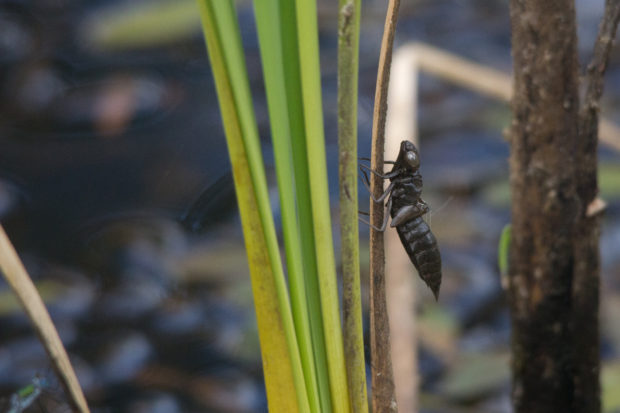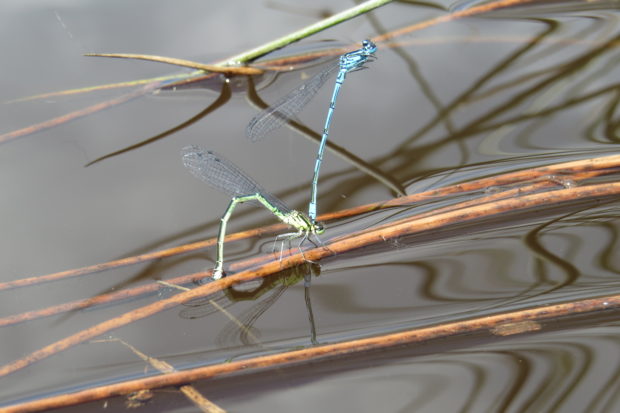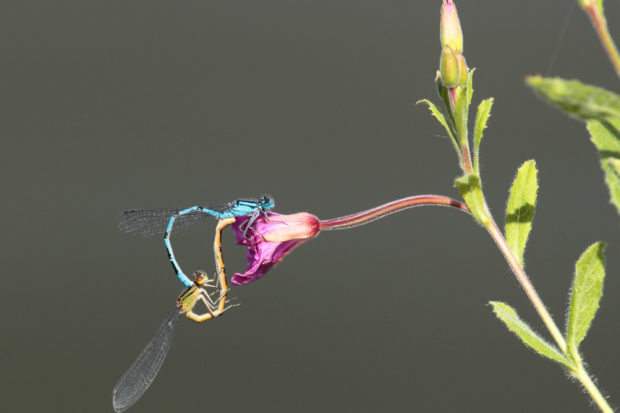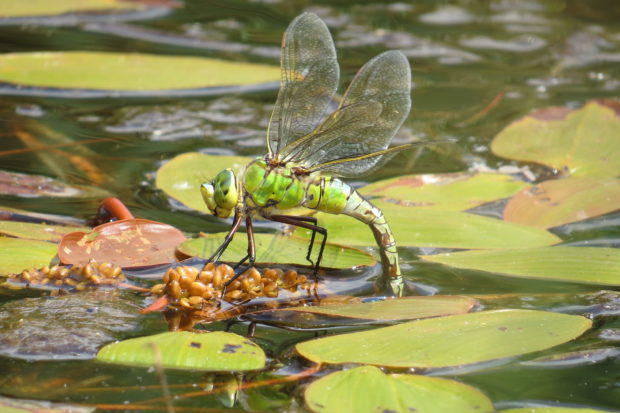Here be Dragons: The Birds and The Bees and The Abdominal Claspers
Entering September, it’s getting on a bit in the season. The heather has started to turn, most butterflies have had their day, but those brave dragonflies and damselflies can still be found gliding around in the late summer sky. This week I have seen plenty of Common Darters, a few Emperor Dragonflies, and the Migrant Hawkers are still out and about! So keep on looking, summer isn’t over yet.
This week I wanted to talk a bit about the fascinating, and sometimes frantic, lifecycle of Odonata. From egg to larvae to flying beast, it’s a bit of a journey with moves that even a professional contortionist would be proud of. The dragonfly and damselfly mating technique is pretty unique, but I’ll do my best at simplifying the Odonata sutra…
Firstly the male manoeuvres his sperm from the end of his abdomen up to his secondary genitalia near the top of the abdomen – where it meets the thorax (main body). Using his abdominal claspers, at the end of tip of the abdomen, he then grasps a female by the back of the head in a loving and caring embrace known as the Tandem Position. They then move into the Wheel Position, where the female curls the tip of the abdomen up underneath her body to grab onto the secondary genitalia of the male and transfers the sperm. A simple transaction that can take a few seconds, or a slightly longer process that can take many hours!
In many species the male will then either stay in tandem position with the female, or just stick close by, in order to protect her as she deposits eggs. There are two types of egg laying tactics deployed by Odonata:
- Endophytic eggs. Elongated eggs that are injected into something, either live plants, dead plants, rotten wood or mud. Eggs are placed either within a water body, or in material close to the waters edge. Willow Emerald Damselflies actually inject theirs into the bark of willow or alder trees!
- Exophytic eggs. Round and in jelly, essentially like frogspawn, just loosely deposited into water. Easy. Common Darters are a prime example of this, repeatedly dipping their abdomens into the water.
The larva emerge from the eggs and moult (shed skin) quickly. Most of their lives are spent in the larval stage, as absolute terrors of the deep, but again this differs between species. It can be as much as a few years, or as little as a few months for damselflies. They eat everything they can with their hinged jaws that shoot out like the beasts from the Alien films. They are savages, even eating tadpoles, small fish and themselves (and by themselves I mean each other not literally their own legs). After they have gorged themselves and moulted a few times, they prepare to erupt into a glorious winged adult. Unlike other insect species, dragon and damselflies skip out the pupal stage (like a butterfly chrysalis) and go straight from larva to adult.
Crawling up to a suitable perch they push their body out through the top of the thorax, bursting out like… an Alien again. The wings and abdomen are expanded over the course of the next few hours as the insect warms up and prepares for its first flight. Newly emerged adults are called tenerals and are a bit vulnerable to predation at this stage. Whilst acquiring adult colouration then spend a week or so away from water eating as much as they can in preparation for their prodigal return to a terrorise a nearby waterway and begin the cycle all over again!

The empty larval case of a Migrant Hawker (may recognise this photo from another blog. Recycling is good for the environment).
If you have a pond you may see some of these larvae over the winter, watch closely and you might spot them gobbling up some other poor aquatic souls! And if you don’t have a pond now is a great time to make one! For far more comprehensive dragonfly biology and life-cycle information check out the British Dragonfly Society’s page, and I’ll see you next time.
Warden Jamie



